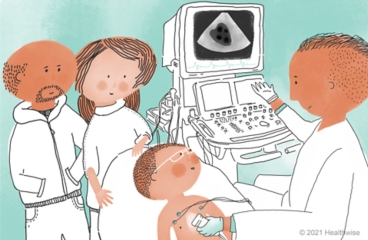What is it?

An echocardiogram (also called an echo) uses sound waves to make an image of your child's heart. A device called a transducer sends sound waves that echo off your child's heart and back to the transducer. These echoes are turned into moving pictures of your child's heart that can be seen on a video screen.
In a transthoracic echocardiogram (TTE), the transducer is moved across your child's chest or belly. A TTE is the most common type of echocardiogram.
Why is this test done?
This test is done to check your child's heart health. It's used for many reasons. Your doctor may use an echocardiogram to look for:
- A heart murmur.
- Heart problems your child was born with (congenital heart disease).
- Heart, lung, or blood vessel problems.
How do you prepare for the test?
It's important that your child lie still during this test. Your child may get medicine to help your child relax.
How is the test done?
- Your child may be asked to remove their clothes above the waist. Your child may be given a cloth or paper covering to use during the test.
- Your child will lie on their back or left side on a bed or table.
- Your child may receive medicine through a vein (intravenously, or I.V.). The I.V. can be used to give your child a contrast material. This helps your doctor get good views of the heart.
- Small pads or patches (electrodes) will be placed on the skin of your child's chest to record the heart rate during the test.
- A small amount of gel will be rubbed on the side of your child's chest to help pick up the sound waves.
- The transducer will be pressed firmly against your child's chest and moved slowly back and forth. It is usually moved to different areas on the chest or belly to get specific views of your child's heart.
- Your child will be asked to do several things, such as hold very still, breathe in and out very slowly, hold their breath, or lie on their left side.
- When the test is over, the gel is wiped off and the electrodes are removed.
What are the risks of the test?
There are no known risks from having this test.
- No electricity passes through your child's body during the test. There is no danger of getting an electrical shock.
- Your child will receive no radiation.
What happens after the test?
- Your child probably will be able to go home right away. It depends on the reason for the test.
- Your child can go back to their usual activities right away.
Follow-up care is a key part of your child's treatment and safety. Be sure to make and go to all appointments, and call your doctor if your child is having problems. It's also a good idea to keep a list of the medicines your child takes. Ask your doctor when you can expect to have your child's test results.
Current as of: October 2, 2025
Author: Ignite Healthwise, LLC Staff
Clinical Review Board
All Ignite Healthwise, LLC education is reviewed by a team that includes physicians, nurses, advanced practitioners, registered dieticians, and other healthcare professionals.

